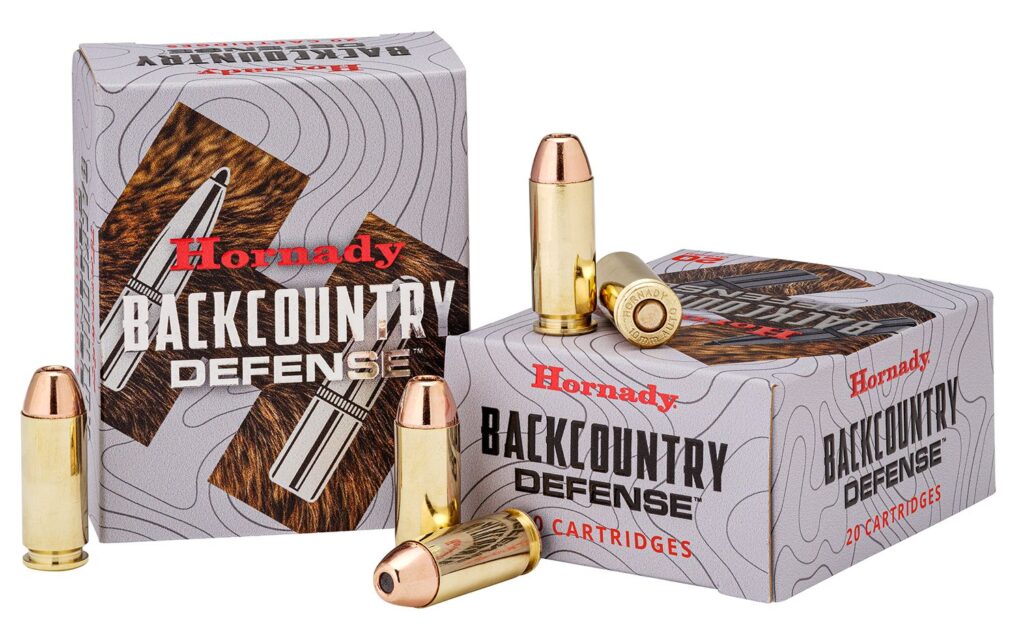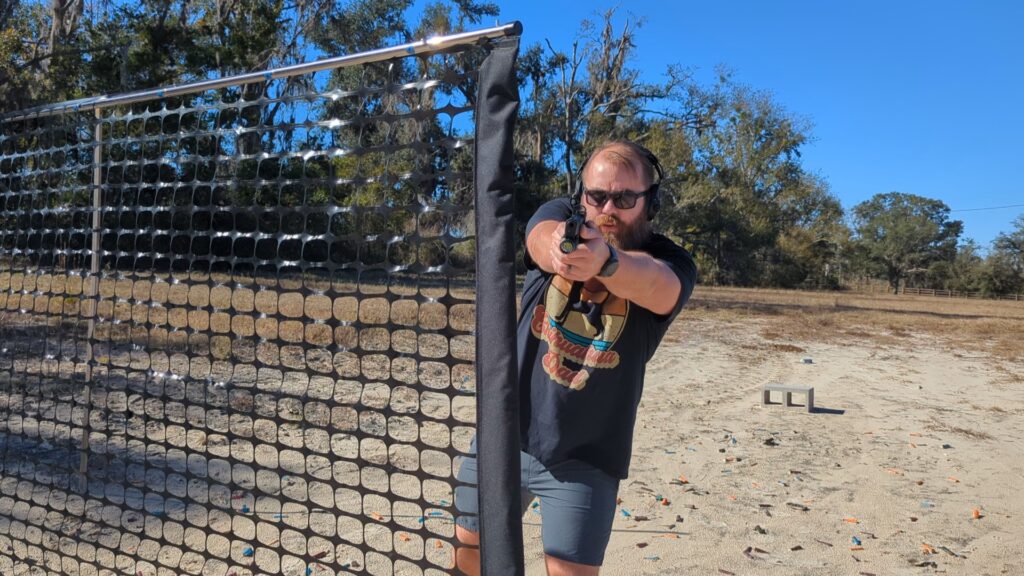 Like Travis said both he and I shot the new CPP Qualification.
Like Travis said both he and I shot the new CPP Qualification.
Right off the face here’s what I like:
- The course uses a realistic threat target instead of a bullseye
- There is both a time and accuracy standard
- The drills emphasize drawing from the holster, realistic sidearm employment
- The qualification grades proper employment of fundamentals
Like Travis, I shot the Qual ‘cold’. No warm up shooting drills. This is the most objective way to grade where your skill set is on demand. I used my Sig Sauer P226 Legion, a G-Code Optimal Drop Pistol RTI holster, and G-Code Softshell Scorpion magazine pouch.
Advertisement — Continue Reading Below
 I used an IPSC Silhouette and an adjusted head box to score. The Box would be 10, outside the box would be 4 to match the CPP metric. On the body A would be 10. Within an inch of A bottom, left, or right would be 8. The remainder of C outside that inch would be 6. D would score 4. The timer application I used was IA’s Shot Timer. The app could not consistently pick up shots indoors but the par time function was all I needed.
I used an IPSC Silhouette and an adjusted head box to score. The Box would be 10, outside the box would be 4 to match the CPP metric. On the body A would be 10. Within an inch of A bottom, left, or right would be 8. The remainder of C outside that inch would be 6. D would score 4. The timer application I used was IA’s Shot Timer. The app could not consistently pick up shots indoors but the par time function was all I needed.
Stage 1 – 7 Yards
 The Qual chart (see above) is written in ‘Interations’ or rounds fired. Times iterations are repeated in (parentheses) below the iteration. Total rounds for the drill. The time limit standard. ‘Mode’ is your method of engagement on the target. “Fill Plan’ gives you how many rounds should be loaded in your weapon and how many should be on standby in a spare magazine and loose.
The Qual chart (see above) is written in ‘Interations’ or rounds fired. Times iterations are repeated in (parentheses) below the iteration. Total rounds for the drill. The time limit standard. ‘Mode’ is your method of engagement on the target. “Fill Plan’ gives you how many rounds should be loaded in your weapon and how many should be on standby in a spare magazine and loose.
Advertisement — Continue Reading Below
The ‘Fill Plan’ can be a little complicated to wrap your head around but it’s meant to keep you ready and loaded for the next drills and stages. Don’t stress it.
Stage 1 Drill 1 – Controlled Pair in under 5 seconds from the holster x3
 Stage 1 Drill 2 – Failure to Stop in under 7 seconds from the holster x2
Stage 1 Drill 2 – Failure to Stop in under 7 seconds from the holster x2
Advertisement — Continue Reading Below
 Stage 1 Drill 3 – Speed Reload in under 9 seconds from the holster. 2 rounds, reload, 2 rounds.
Stage 1 Drill 3 – Speed Reload in under 9 seconds from the holster. 2 rounds, reload, 2 rounds.
 Stage 1 encompasses all the fundamentals of defensive carry pistol shooting using USMC standard drills. It also incorporates headshots and a speed/emergency reload from slide lock. All drills are under a generous time standard that should be able to be shot at a relaxed pace without taking an overly long time. In the ‘Crawl, Walk, Run’ methodology it’s a brisk walk.
Stage 1 encompasses all the fundamentals of defensive carry pistol shooting using USMC standard drills. It also incorporates headshots and a speed/emergency reload from slide lock. All drills are under a generous time standard that should be able to be shot at a relaxed pace without taking an overly long time. In the ‘Crawl, Walk, Run’ methodology it’s a brisk walk.
Stage 2 – 15 Yards
Advertisement — Continue Reading Below
 Stage 2 Drill 1 – Controlled Pair in under 6 seconds from the holster x6. Tactical reload after the third controlled pair.
Stage 2 Drill 1 – Controlled Pair in under 6 seconds from the holster x6. Tactical reload after the third controlled pair.
 Stage 2 Drill 2 – Speed Reload in under 12 seconds from the holster. 2 rounds, reload, 2 rounds.
Stage 2 Drill 2 – Speed Reload in under 12 seconds from the holster. 2 rounds, reload, 2 rounds.
 Stage 2 encompasses a high degree of basic pistol marksmanship with holster draw. At 15 yards grip, sight picture and alignment, trigger press, and follow through must all be well executed to score high enough for sharpshooter and expert ratings. Time standards are still generous but penalize slow reactions which in a real world situation are lethal. A second speed/emergency reload is performed, these reloads are the most physically and mechanically involved drills where trying to rush will generally cost you more time than being slow.
Stage 2 encompasses a high degree of basic pistol marksmanship with holster draw. At 15 yards grip, sight picture and alignment, trigger press, and follow through must all be well executed to score high enough for sharpshooter and expert ratings. Time standards are still generous but penalize slow reactions which in a real world situation are lethal. A second speed/emergency reload is performed, these reloads are the most physically and mechanically involved drills where trying to rush will generally cost you more time than being slow.
Advertisement — Continue Reading Below
Stage 3 – 25 Yards
Stage 3 Drill 1 – Single Action (if applicable) slow fire from low ready/tactical carry in under 7 seconds x8
Advertisement — Continue Reading Below
 Stage 3 is pure marksmanship on a lighter trigger. The pistol is drawn and held and you have 7 seconds to squeeze of a round center mass. The distance is greater than many shooters are used to training but smooth trigger press and follow through will result in accurate hits.
Stage 3 is pure marksmanship on a lighter trigger. The pistol is drawn and held and you have 7 seconds to squeeze of a round center mass. The distance is greater than many shooters are used to training but smooth trigger press and follow through will result in accurate hits.
Firing the Qual cold showed a little rust in my shooting, recoil anticipation had crept back in, and I had pushed my shots left several times with a combination of to loose grip and overly aggressive trigger press.
But overall…
Advertisement — Continue Reading Below
 Overall I dropped 22 points. This is an Expert rating with a 378/400 but there were still identifiable errors in my shooting. 400 is an achievable score.
Overall I dropped 22 points. This is an Expert rating with a 378/400 but there were still identifiable errors in my shooting. 400 is an achievable score.
The USMC’s new CPP is a fine replacement to the older program and has its fundamental emphasis in the right spots. I would like to see a ‘Table 2’ training program that integrates pistol and rifle shooting with transitions along with barrier, off-hand, and multiple target drills but I feel any of that added here would over complicate this basic qualifier.
More importantly this is an excellent 6 drill series for any shooter practicing. The time metrics are just as useable drawing from concealment as they are from a standard strong side holster and I would recommend using a hit/miss standard for grading out of 40. Treat D zone hits as ½ points in that case on an IPSC target.
Advertisement — Continue Reading Below
Final Thoughts
Travis and I both agree the new CPP is a tremendous improvement over the older ELP. We have similar criticisms on the limits of the CPP but taking into account that this is a qualification and not a training program unto itself it does an acceptable job. Practicing the individual drills within the qual with the aid of a competent instructor will result in gains fundamentally, allowing shooters to more effectively branch out to more complex disciplines of shooting. From the standpoint of the USMC this program, properly implemented, will allow for a greater use of pistols among Marines and would mirror the U.S. Army’s current plan to bring sidearms down to the Team Leader level.















